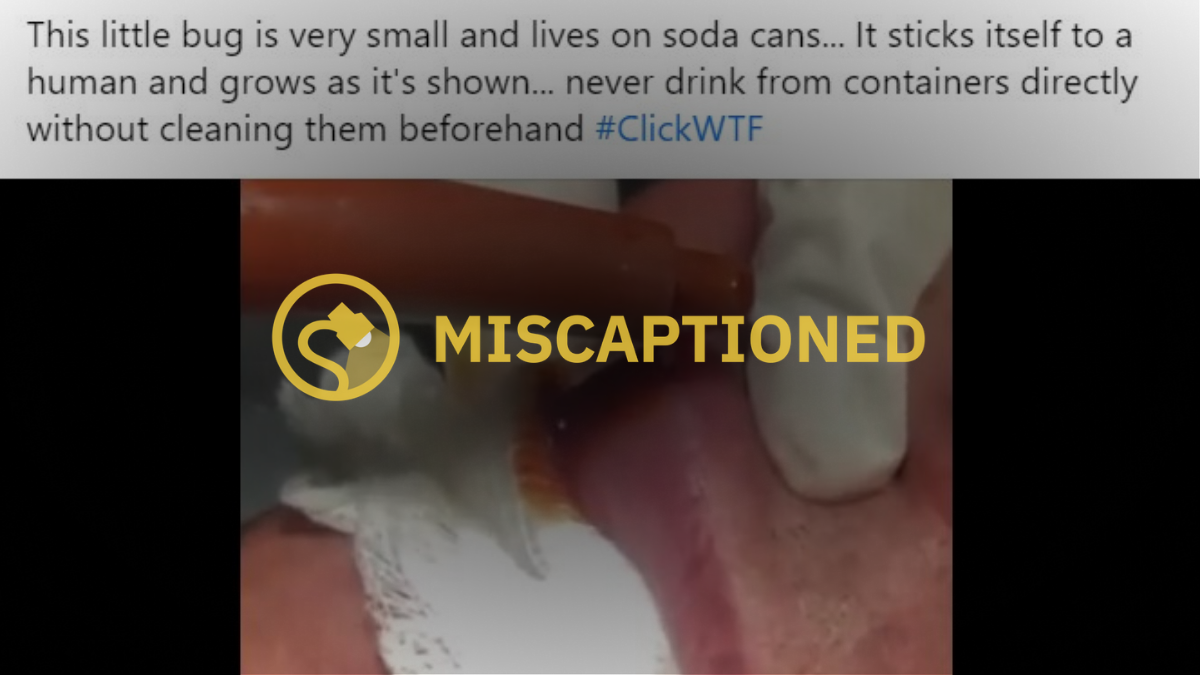This is an actual video of a botfly larva being pulled from a person's lip. This infection likely occurred after a botfly laid its eggs on a mosquito, which were then transferred to a human via a mosquito bite. However, the insect that caused this infection does not live on soda cans.
A disturbing video of insect larvae being pulled from a person's lip is frequently circulated online along with a warning to never drink straight from a can. This video, which may be difficult viewing for some people, is often shared with the following caption:
"This little bug is very small and lives on soda cans... It sticks itself to a human and grows as it's shown... never drink from containers directly without cleaning them beforehand #ClickWTF"
This video, again, is difficult to watch. Viewers be warned:
https://www.youtube.com/watch?v=lsFajcWc2Rw
This is a genuine video of a larva being removed from a person's lip. However, the viral caption is incorrect. This small bug does not live on soda cans. The above-displayed video shows a botfly larva being removed from a person's lip and botflies do not live on soda cans.
María Ángel Marcos García, an entomologist and professor of Zoology at the University of Alicante, told the Spanish fact-checking outlet Maldilta.es (translated via Google):
"It is without any doubt the larva of Dermatobia hominis , a dipteran whose larvae are parasitic and live inside the tissues of vertebrates. This species does not live in Europe but is native to Central America and is also present in some countries from South America."
[...]
"The adult of this species does not lay the egg directly on our body" but instead puts it in the body of other diptera (mosquitoes or house flies) "and when they land on us, the eggs hatch with the heat and that is when the larva passes and settles in our body, entering through a hair follicle or through the mosquito's own bite. This parasitization is called myiasis and lasts about 8 weeks, which is how long it takes for the larva to leave our body."
Here's how the infestation process of the Dermatobia hominis, or human botfly, was described in a 2019 paper published in the journal "Nursing":
To reproduce, female botflies lay eggs on blood-sucking arthropods such as mosquitoes or ticks. The infested arthropods deposit larvae from the eggs when they bite a human or other mammal. A botfly larva enters the host's skin through the bite wound or a hair follicle and burrows to subcutaneous tissue.2 It grows there for 6 to 10 weeks, breathing through two posterior spiracles that lie flush with the host's skin. The resulting boil-like lesion, or furuncular myiasis, is commonly misidentified as a methicillin-resistant Staphylococcus aureus (MRSA) infection and treated inappropriately with antibiotics.
Patients with botfly infestation often describe feeling movement under the skin as the larva feeds and grows, but it does not travel in the body. Once mature, the larva drops to the ground and pupates in soil.
We have not been able to find the original version of this viral video. It has been circulating online since at least 2019, and has been shared under a variety of captions. Some claimed it was some sort of kissing disease (it's not), others claimed it was related to COVID-19 (nope), but the most popular (and false) claim was that it showed the result of drinking from an unwashed soda can.
While we couldn't find the original video, we did find a few videos showing similar cases. Here's a clip from a 2019 episode of "The Doctors," in which they discuss the cause of these infections.
https://www.youtube.com/watch?v=QFQwUYBLixQ
These viral videos do not have anything to do with soda cans.
Interestingly, this is far from the first time that a scaremongering rumor has circulated about an illness being spread via unwashed soda cans. While wiping down the tops of your cans isn't bad advice, the rumors we've investigated about deaths or severe illness being caused by unclean cans have proven false.
Sources:
6-Inch Roundworm Found in Woman’s Lip! www.youtube.com, https://www.youtube.com/watch?v=QFQwUYBLixQ. Accessed 26 Aug. 2021.
“El horripilante bulo de los parásitos en la lata de refrescos que no debes creer.” El Español, 30 Jan. 2020, https://www.elespanol.com/social/20200130/horripilante-bulo-parasitos-refrescos-no-debes-creer/463454085_0.html.
“FACT CHECK: Can You Catch Leptospirosis from Rat Urine on Soda Cans?” Snopes.Com, https://www.snopes.com/fact-check/rat-urine-soda-cans/. Accessed 26 Aug. 2021.
“Here’s Why It Never Hurts To Give Your Soda Can A Rinse.” Consumerist, 6 Feb. 2013, https://consumerist.com/2013/02/06/heres-why-it-never-hurts-to-give-your-soda-can-a-rinse/.
McAteer, Oliver. “Woman Has Huge Maggot Removed from Lip.” Metro, 17 Aug. 2015, https://metro.co.uk/2015/08/17/woman-has-huge-maggot-removed-from-lip-5346658/.
“No, el ‘bichito’ que sacan de un labio en este vídeo no ‘se encuentra en las latas y botellas de refrescos’ · Maldita.es - Periodismo para que no te la cuelen.” Maldita.es — Periodismo para que no te la cuelen, 28 Jan. 2020, https://maldita.es/malditaciencia/20200128/no-el-bichito-que-sacan-de-un-labio-en-este-video-no-se-encuentra-en-las-latas-y-botellas-de-refrescos-es-una-larva-de-mosca-presente-en-america-que-entra-en-el-cuerpo-por-picaduras-de-otras/.
Simon, Matt. “Absurd Creature of the Week: Burrowing Botfly Grows Huge Feasting on Your Flesh.” Wired. www.wired.com, https://www.wired.com/2013/10/absurd-creature-of-the-week-botfly/. Accessed 26 Aug. 2021.
Parsh, Sophia; Parsh, Bridget EdD, MSN, RN, CNS Treating parasitic human botfly, Nursing: July 2019 - Volume 49 - Issue 7 - p 65-66
doi: 10.1097/01.NURSE.0000558094.46217.e1

